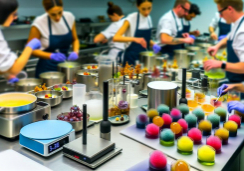Creating Nutritious Vegan Recipes: Essential Tips
As a chef meticulously selects the finest ingredients to create a culinary masterpiece, so must you choose the right components to craft nutritious vegan recipes that are as satisfying as they are healthy.
You're not just tossing together salads; you're exploring a bounty of textures and flavors that can mimic traditional dishes and satisfy all palates.
It's crucial to understand the balance of macronutrients, ensuring that you're incorporating protein-rich legumes, whole grains, and a colorful array of vegetables into your meals.
You'll find that mastering the art of substitution is key—flaxseed meal and chia seeds can become your go-to egg replacements, while nutritional yeast and cashew cream can lend a cheesy flavor without any dairy.
As you stand in your kitchen, ready to embark on this culinary journey, remember that the secret to a successful vegan recipe lies not only in what you add but in how you combine these ingredients to create a symphony of taste and nutrition.
Stay tuned to uncover the essential tips that will guide you through this process, ensuring that every dish you create is a testament to the rich possibilities of vegan cuisine.
Assess Nutritional Balance
When planning your vegan meals, it's crucial to evaluate your intake of macro and micronutrients to ensure your diet is nutritionally complete and balanced. A well-rounded vegan diet includes a variety of fruits, vegetables, whole grains, legumes, nuts, and seeds. These provide a wide array of essential nutrients that are vital for maintaining health.
To achieve nutritional balance, you should monitor your levels of protein, iron, calcium, and vitamin B12. Protein can be found in foods like black beans and other legumes, while iron is abundant in leafy greens and fortified cereals. Calcium is present in fortified plant-based milks and dark green vegetables. Vitamin B12, which is critical for nerve function and blood formation, isn't naturally present in plant foods. Including fortified foods or supplements, such as nutritional yeast, is an effective way to meet your B12 requirements.
Additionally, assess the balance of carbohydrates, fats, and proteins in your daily meals. Ground flaxseed is an excellent source of omega-3 fatty acids and can be easily incorporated into your diet. Don't forget the importance of variety; aim for a rainbow of colors on your plate to ensure a broad spectrum of nutrients.
Keep these essential tips in mind for a nutritionally adequate plant-based diet.
Substitute Animal Products
To successfully replace animal products in your vegan cooking, it's essential to explore various plant-based alternatives that can mimic the flavors and textures of traditional ingredients.
When it comes to eggs, a flax egg — flaxseed meal mixed with water — acts as a fantastic binder in baked goods. For a buttery richness, opt for vegetable oils or nut butters, while olive oil and tahini can be great substitutes for buttery spreads.
For creamy dishes that typically require heavy cream, don't hesitate to use whipped coconut cream, pureed silken tofu, or plant-based versions like coconut milk and soy milk. These simple swaps maintain the lush texture you're after.
If you're crafting a recipe that calls for cheese, vegan cheese made from blended nuts, nutritional yeast, salt, and garlic powder can offer a similar taste experience.
When meat is off the menu, turn to extra-firm tofu or umami-rich ingredients like roasted mushrooms, blended with nuts, seeds, and beans to create meaty textures and flavors.
And remember, for sweetness without the animal products, maple syrup is a versatile and delicious alternative to honey.
With these tips, your vegan dishes will be both nutritious and satisfying.
Experiment With Flavors
After mastering the art of substituting animal products, you'll find that experimenting with different herbs, spices, and seasoning blends can truly elevate your vegan dishes to new heights of flavor. Vegan cooking thrives on creativity, and a well-seasoned dish can dazzle the palate and satisfy even the most discerning taste buds.
To guide you in your culinary journey, here are some tips to help you experiment with flavors:
- Incorporate umami-rich ingredients such as miso paste, soy sauce, and nutritional yeast to add depth and a savory punch to your meals.
- Don't shy away from bold spices like smoked paprika and garlic powder; they can transform simple ingredients like bell peppers into a smoky, aromatic experience.
- Be adventurous and combine contrasting flavors and textures, creating dishes that are as exciting to eat as they're nutritious.
Plan and Prep Efficiently
Efficiently planning and prepping your meals, by washing and cutting extra vegetables to store for later use, can streamline your cooking process and save you valuable time in the kitchen. When you set up your kitchen for success, you're paving the way for quick vegan dishes that don't compromise on nutrition or taste.
Begin by learning the basics of meal prepping. This practical approach involves having most recipe components ready before you even start to cook. By doing so, you can whip up Easy Vegan Recipes in no time. Keep a collection of 5 to 6 favorite recipes that are both easy and enjoyable. This will save you from the daily hassle of deciding what to cook and prevent last-minute grocery runs.
Batch cooking is a lifesaver for many. It means you're cooking large quantities of vegan meals at once, ensuring you have ready-to-eat plant-based meals for the entire week. Use your favorite spices and seasonings to add variety to your meals, so you don't get bored of eating the same dish.
What are the essential tips for creating nutritious vegan recipes?
When creating nutritious vegan recipes, it’s important to focus on fresh, whole ingredients. Expert tips for healthy vegan recipes include incorporating a variety of fruits, vegetables, whole grains, and plant-based proteins. Experiment with different herbs and spices to elevate the flavors, and don’t forget to add healthy fats like avocado or nuts.
Master Vegan Cooking Techniques
Having mastered the art of meal prepping, you'll find that learning essential vegan cooking techniques can further elevate your kitchen prowess and expand your culinary repertoire. As a recipe developer, you know that vegan recipes require creativity, especially when replacing traditional ingredients. Vegan baking, for example, often involves finding alternatives for eggs and dairy.
Implement these techniques to enhance your vegan food creations:
- Egg Replacements: For binding, use flaxseed meal or chia seeds mixed with water. Silken tofu or mashed bananas also work well, especially in moist recipes like cakes or muffins.
- Butter Alternatives: In both cooking and baking, opt for vegetable oils or olive oil. For richer flavor, tahini or nut butters can be excellent substitutes.
- Dairy-Free Cream: Whipped coconut cream adds lightness to desserts, while pureed silken tofu, coconut milk, or soy milk can mimic heavy cream in sauces and soups.
These vegan cooking techniques won't only add variety to your plant-based recipes but also enrich the nutritional profile of your dishes. By incorporating vegan ingredients such as chia seeds, you'll create meals that are both wholesome and satisfying.
Practice these methods to become proficient in vegan cuisine and keep your meals exciting and diverse.
Innovate With Plant-Based Ingredients
As you explore protein alternatives in vegan cooking, consider the versatility of tofu and the umami depth of roasted mushrooms to replace meat.
Embracing a variety of whole foods, such as nuts, seeds, and legumes, not only diversifies your diet but also enhances the nutritional profile of your meals.
Mastering flavor combinations with ingredients like nutritional yeast and spices can elevate your dishes, mimicking the complexity found in traditional cheese and meat-based recipes.
Explore Protein Alternatives
To diversify your vegan diet, experiment with protein-packed plant-based alternatives such as tempeh, seitan, lentils, and beans. These ingredients not only make vegan meals more satisfying but also contribute to a well-rounded vegan lifestyle. When crafting delicious vegan recipes, consider these protein alternatives:
- Tofu and Edamame: These soy-based options are versatile and can mimic various textures and flavors.
- Ancient Grains: Quinoa and amaranth offer a complete protein profile, essential for plant-based foods.
- Hemp Seeds and Spirulina: Sprinkle these into smoothies or on salads for a protein boost.
Embrace Whole Food Variety
Building on your exploration of protein alternatives, consider broadening your culinary horizons further by embracing the myriad of whole foods available for plant-based cooking. To innovate your vegan recipes, integrate a spectrum of plant-based proteins, fruits, vegetables, grains, nuts, and seeds.
This variety not only ensures a balanced diet but also introduces an array of textures and flavors into your meals.
Find vegan cheeses to add creaminess to savory dishes or utilize herbs and spices for an extra flavor kick. Cooking tips like roasting, steaming, or grilling can transform simple ingredients into delectable food.
Mastering Flavor Combinations
Delve into the art of flavor harmony by pairing plant-based proteins with the right herbs, spices, and condiments to elevate your vegan dishes. To ensure your meals burst with taste, take note of these tips and tricks:
- Experiment with different plant-based proteins and use herbs and spices liberally to create satisfying dishes.
- For a richer, umami flavor, consider condiments like miso paste, soy sauce, and nutritional yeast.
- When baking, ground flaxseed and chia seeds can be used to make meringues and other egg-based recipes.
Smart swaps include using beans and pulses for their versatility and nutritional value. If you're unsure where to start, look into meal delivery services or follow a food blogger for inspiration. This approach will take your dish to the next level.
Conclusion
In wrapping up, remember that crafting balanced vegan dishes is straightforward when you're informed. Swap out animal products with plant-based alternatives like flaxseed, tofu, and nutritional yeast to maintain nutrition without sacrificing taste.
Experiment with diverse flavors to keep meals exciting. Plan your meals and prep in advance for efficiency. Hone your vegan cooking skills for better texture and flavor.
By innovating with various plant-based ingredients, you'll enjoy a diet that's as nutritious as it's delicious.










